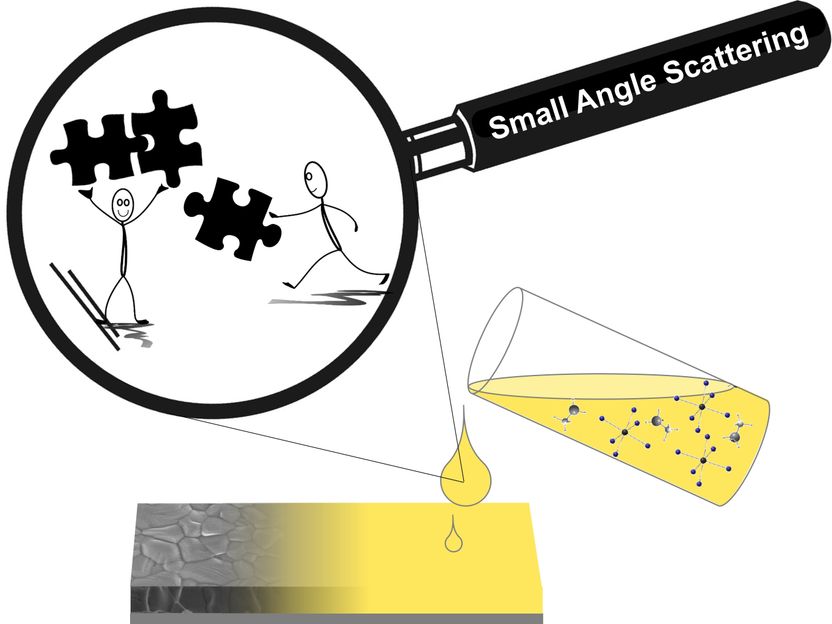Perovskite Solar Cells: Insights into early stages of structure formation
Colloidal chemistry of perovskite precursor solutions investigated
Using small-angle scattering at the PTB X-ray beamline of BESSY II, an HZB team was able to experimentally investigate the colloidal chemistry of perovskite precursor solutions used for solar cell production. The results contribute to the targeted and systematic optimization of the manufacturing process and quality of these exciting semiconductor materials.

Using Small-Angle Scattering the early stages of structure formation in precursor solutions of perovskite solar cells have been explored.
© M. Flatken/HZB
Halide perovskite semiconductors are inexpensive, versatile, and high-performance materials used in solar cells as well as optoelectronic devices. The crystalline perovskite thin films required for this purpose are prepared at low temperature from solution: While the solvent evaporates during an annealing step, highly coordinated iodoplumbates interact and subsequently form the polycrystalline thin film. The quality of the thin film ultimately determines the performance of the semiconductor material. Up to now, it has not been possible to achieve a comprehensive impression of the role of the colloidal chemistry in the precursor that is considered to be directional for crystallinity and the further processing.
Observing the formation of structures
Now, an HZB team led by Prof. Antonio Abate has used small-angle scattering to experimentally determine how the initially disordered elements in the precursor solution find their way into primary subunits, interacting and thus providing a first "pre crystalline" arrangement for further conversion to perovskite thin films.
The results indicate that primary subgroups consisting of lead and iodine are formed, so-called iodoplumbates, in which a lead atom is octahedral surrounded by six iodine atoms. These subunits further form a dynamic colloidal network into which the organic methylammonium cation is incorporated, from which the familiar perovskite structure arises.
"While conventional methods have so far limited us to measure only highly diluted precursor solutions, HZB's ASAXS instrument at PTB's FCM beamline at BESSY II makes it possible to study the precursor at a concentration applicable for solar cell fabrication," emphasizes Marion Flatken, who carried out the measurements as part of her PhD thesis.
Small Angle Scattering data show clear evidence
"Small-angle scattering is ideally suited for measuring nanoparticles and substructures in solutions," explains Dr. Armin Hoell, an expert for small-angle scattering and a corresponding author of the study. "The measured data provide clear evidence for the formation of initial nanometer-sized clusters, which fit the PbI6 octahedron well in terms of dimension and organize themselves in a concentration-dependent manner. Importantly, the measurements are also highly reproducible."
The presented technique and related results can help to further optimize the fabrication process and to more systematically control the quality of perovskite thin films during solar cell fabrication striving for optimal performances.
Original publication
Original publication
Marion A. Flatken, Armin Hoell, Robert Wendt, Eneli Härk, André Dallmann, Albert Prause, Jorge Pascual, Eva Unger and Antonio Abate; "Small-angle scattering to reveal the colloidal nature of halide perovskite precursor solutions"; J. Mater. Chem. A; 2021
Organizations
Other news from the department science

Get the analytics and lab tech industry in your inbox
By submitting this form you agree that LUMITOS AG will send you the newsletter(s) selected above by email. Your data will not be passed on to third parties. Your data will be stored and processed in accordance with our data protection regulations. LUMITOS may contact you by email for the purpose of advertising or market and opinion surveys. You can revoke your consent at any time without giving reasons to LUMITOS AG, Ernst-Augustin-Str. 2, 12489 Berlin, Germany or by e-mail at revoke@lumitos.com with effect for the future. In addition, each email contains a link to unsubscribe from the corresponding newsletter.























































